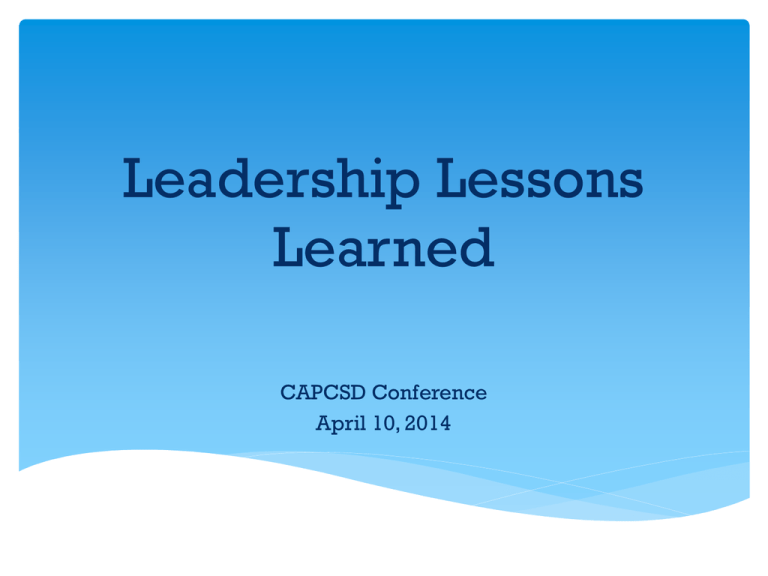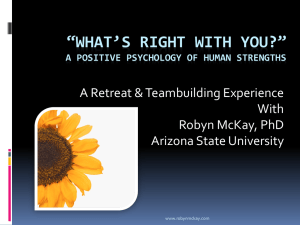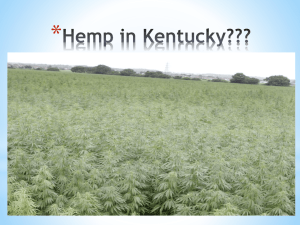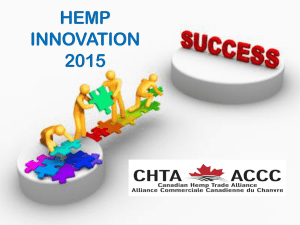Intentional Leadership
advertisement

Leadership Lessons Learned CAPCSD Conference April 10, 2014 Theory to Practice -The Pragmatics of Leadership -To lead well is to move an enterprise forward with integrity, vision and a positive attitude using whatever resources at your disposal Reframing Leadership Structural Leader Human Resource Leader Social Architect Analysis/Design Catalyst/Servant Support/Empowerment Political Leader Symbolic Leader Advocate/Coalition Builder Prophet/Poet Inspiration/Frames Experience Leadership QUALITIES: Strong Core Values Focused Optimistic Leadership Strong Core Values (Holding the Center) Leadership -Integrity -Today there is no clear path for leaders, especially for women (Bateson, 1990; Sandberg, 2013) Leadership is changing and constantly redirected Leadership is improvising, like language learning -Integrity Creating external works in research, courses, programs takes courage to hold onto the past and break free. Creating oneself as a leader takes courage and staying centered. How to Live…Montaigne -Twenty Attempts to answer how to conduct an honorable and correct life (Bakewell, 2010). -Moral dilemmas of Leadership. -Good of the few over good of the many Tobacco free campus -Short term good over long term good Hiring more tenure track faculty Leadership Losing Giving it up to the “Lord” Leadership Focused (Holding the Center) Focusing as Leader -Primary task of leader is to direct attention of others (Goleman, 2013) -Understand your own biases -Cultivate a triad of awareness Inward Focus “Know Self” Other Focus “Know Team” Outward Focus “Know Larger World” Leadership Optimistic Embrace Change or Fear Change -Presidents with gray hair and gray suits bemoaning change -Language of defeat -Not wanting to learn about new ways of doing business -Spiraling downward -Higher Education is in denial…so much for critical thinking How to Find a Way -Being Ridiculously In Charge (Cloud, 2013) -”Find a Way Thinking,” Nick Roddey (2013) -Asking How We Could Do “IT” -Then asking what might be problems -Once committed, Failure is not an option -Showing people that they can do what they don’t realize they can do…”getting Ripiched” Innovation as Opportunity -The Innovative University (Christensen, Eyring, 2011) disruptive innovation as good -Innovative Incubator Project, UNE 2014: Bill and Melinda Gates Foundation Competency Based Online BS in Business to be developed in 12 mos. Online growing, competency based degrees coming. Adapt or atrophy. Leadership SKILLS: Spinning the Plates Being Responsible/Taking Risks Keeping Equity and Balance Leadership Spinning the Plates Leadership Keeping Equity and Balance (Cutting the Cake) Leadership Being Responsible/Taking Risks (Picking Winners) Blue Ocean - Less than 1% Science Students Study abroad - Problem/Strategy Global Study: Costs extra and loans too much already Can’t get good lab courses Made cost neutral Built Science labs Maine to Morocco in 15 months Eliminated costs/created new product Blue Ocean Strategy - How to create market space and make competition irrelevant (Kim, Mauborgne, 2005) - Leave the bloody waters by the shore and go for the Blue Ocean, the deep water. - VALUE INNOVATION occurs where costs savings eliminate factors industry competes on and creates elements industry never offered. Leadership Most Important Asset: A Leader Must Love to Lead! Resonant Leadership -Power Stress can lead to dissonance(Boyatzis & McKee, 2005) -Leadership requires personal sacrifice and this leads to inability to sustain the self -Renewal requires: Mindfulness, a state of whole awareness of life. Hope, a belief in a better future. Compassion, understanding of human motivations. Leadership - Seven Secret Steps Spinning the Plates Focusing For and On Others Cutting the Cake Holding the Center Returning the Investment Seeing the Best Loving the Work Active Verbs – Leadership Takes Action Intentional Leadership: Harnessing Potential In People & Programs “Leadership matters” Gail M. Whitelaw, PhD The Ohio State University whitelaw.1@osu.edu Leadership matters: The science of leadership: Challenging the myths Evidence based leadership Diversity in leadership Gender Generation Strengths Creating a culture of leadership in Communication Sciences and Disorders Defining leadership: Leadership is a developmental process of growing one's skills in leading others with an awareness and knowledge of our own honesty and integrity. (Leadership Center at The University of North Georgia) Leadership is a process of social influence, Defining leadership: What leadership is NOT: Seniority or position in the hierarchy Titles Personal attributes (leadership is not an adjective) Management (Kruse, 2013) Some considerations in leadership (Loeb and Kindel, 1999) The “natural leader” Charisma should not be confused with skill Confusing leadership with command (the authority to lead) Confusing leadership with management (focus on tasks, do things) (an ongoing theme) The old adage of “manage things, lead people” Managing vs. leading Leaders First who, then what? Focus on people and getting the “right people on the bus”, then getting them in the right seats (Collins, 2001) Part of why we hope you are here today— addressing how to get people on the bus Leaders do the right things; not to be confused with the popular things: A couple of examples from professional organizations Business being business vs. friendship being friendship! Leadership matters Studies vary in the influence that leaders have in an organization, from less than 10% of difference between best and worst organization to being all knowing Pfeffer and Sutton (2006) indicate that although effects of leadership are overstated, there are many rigorous field studies and experiments that document situations in which leadership skills and actions have significant impact (See Goethals, Sorenseon, and Burns, 2004) Theories of Leadership There is a science of leadership that can be applied to this process Have evolved and changed over the years, some with research, some with changes in the “culture” in which leadership occurs, some with a generational approach Some vogue, some recycled and “old school” Themes in leadership Where we’ve been, where we’re going Where we’ve been “Leaders are born, not made” Theories that are based on the individual as leader and what they are “born with” “Great man theory” Trait theory (Stogdill, 1948, 1974) People are born with traits that make them particularly suited to leadership. These skills would include a combination of goal orientation, ambition, and decisiveness. May identify a particular personality or behavioral characteristic shared by leaders. Outdated, as these traits are based on trait studies first in the 1940’s, then in the 1970’s “Leaders are made, not born” Behavioral theories Successful leadership is based on a well defined set of behavioral that can be learned through teaching and observation Based on teaching leaders a set of skills in order to be leaders Rooted in the psychological theory of behaviorism, this leadership theory focuses on the actions of leaders Organizational Theories These set of theories are based on the leader being “in change” of the organization and focus on a leader/follower hierarchy Transactional theory of leadership: People are motivated by “reward and punishment” Clear chain of command and clear structure for followers Also known as “management theories” Used in business—when employees are successful, they are rewarded, when they fail, they are reprimanded Where we are and where we’re going Newer theories of leadership Current theories of leadership Leadership is not just “top down” but also “bottom up” Flatter hierarchy and see many people in the organization in a leadership role, not just “the leader” This type of leadership is sometimes referred to as “thought leadership”—will be referred to here as relational and ethical leadership Relational and ethical leadership theories Theories based on the root concept of “authentic leadership”, which helps leaders develop the self-awareness they need to be effective Feedback from those the leader interacts with, 360 degree assessment, getting feedback and using it Theories focus on the relationship between leader and others, not necessarily a hierarchy Theories place a premium on transforming belief into action Focus on creating a positive environment “Servant leadership” https://greenleaf.org/what-is-servant-leadership Principle centered leadership (Covey, 1990) Level 5 Leadership (Collins, 2005) Build a superior team then figure out the best path to greatness: this concept is “first who, then what”: “getting the right people on the bus then getting them in the right seats” The “Stockdale paradox”: Believe in the end that you will prevail despite difficulties WHILE confronting the most brutal facts about the current reality Believe there will be a positive outcome Level 5 Leadership (Collins, 2005) Vision: Maintain core ideology yet be open to change…understand what is sacred and cannot be changed and what should be open for change Focus is on BHAGs…big, hairy, audacious goals Contrast to management: Focus on getting the day to day things done Biology of Leadership (Goleman and Boyatzis, 2008) Based on theories of emotional intelligence and impact on leadership What happens “in the brain when people interact” Postulated in neurology of interaction Social intelligence is described as a “set of interpersonal competencies, built on specific neural circuits, that inspire people to be effective” As a leader, help brain learn new skill by working hard and garnering information from multiple sources (the 360 degree assessment) Diversity in leadership Channeling the best in individuals and organizations Avoiding “group think” in a new age of leadership The world is full of gatherings for the like- minded. People go to a great deal of trouble to sequester themselves with people who think like them and to screen out people who are different. Instead, leave your comfort zone and seek out diverse people who will challenge your assumptions. If you practice being present, inquiring, and listening, you world will never be the same. Before you know it, you will have crossed divides that would otherwise have been impassable. (Gerzon,2006) Diversity as a key word in leadership Breadth of skills and strengths Balance of gender Are there still biases? Example from my recent presentation/panel Generational considerations Cultural considerations Historical perspectives of leadership in contrast to current needs and demands Diversity in gender in leadership Research that shows stylistic differences Women tend to be more collaborative than men Question is Nature vs. Nurture Evidence of nature: Women and men seem to have neurobiological differences related to communication (how much they talk, what they say, using visual cuing) (Robison, 2005) Evidence of nurture: Women resent being disciplined by other women (theorized that they are rarely rebuked in school and take it personally) from a paper titled “Wait Until Your Father Gets Home” (Atwater as cited in the Economist, 2000) Diversity in gender in leadership Despite earning the majority of college degrees, women make up just 19% of the U.S. Congress, 5% of Fortune 500 CEOs and 10% of heads of state. (Sandberg and Chavez, 2014) The paradox for women If women behave like women, they are viewed as not possessing leadership skills If women behave like men, they are seen as “bullies” “bitches” and “aggressive” Recent focus on the word “bossy”: http://banbossy.com/ Not addressing this can impact profitability of an organization, since gender diversity has been proven to result in better decision making (Gerber in Robison, 2005) Gender mix shows potential for best leadership (Walker, 2004) Generational/cultural considerations “The workplace we inhabit today is awash with the conflicting voices and views of the most age- and value-diverse workforce this country has known since our great-greatgrandparents abandoned field and farm for factory and office.” (Zemke, Raines, and Filipczak, 2000, p. 9) Generational considerations Meta-analysis of generational research: Gen Y and Millennials (contiuum) Collaboration in problem solving Granting and garnering respect Interested in social responsibility; focus on helping others In organizations, comfort and autonomy are important; security is less important to these generations than to previous generations Dedicated, focused on collaborative goals, trusting, relationship focused, optimistic Generational considerations Mentoring and reverse mentoring Reverse mentoring between millennials and boomers (Murphy, 2012) Leaders “…are beginning to realize that knowledge is not a one-way street. It’s in everyone’s best interest to share expertise.” (Greengard, 2002) Building leadership from the “bottom of the pyramid” Communication: Social media http://online.wsj.com/news/articles/SB100014240529702 03753704577255531558650636 Angel’s Advocates: A compliment to the “devil’s advocate”: A new era Bring best thinking to the table before poking holes in it Bring information, insights, and initiate epiphanies Listen to other people Need both devil’s advocates and angel’s advocates Angels are collaborative Devils help to challenge idea and support defense for ideas Banducci, 2005 Theories are fine, but… How do we build a culture of leadership for the future Where will we find tomorrow’s leaders? (Hill, as cited in Hemp, 2008) Current organizational research suggests: There is a need to broaden the search for leadership “Talent isn’t necessarily portable”…example of experience The thought that any experience prepares someone to deal with tragedy, devastation, someone out of their experience level “Homegrown leadership” Where will we find tomorrow’s leaders? (Hill, as cited in Hemp, 2008) Current organizational research suggests: Leadership is about making emotional connections to motivate and inspire people, and our effectiveness at doing this has strong cultural overtones Many talented people have been overlooked: How to recognize the full pool for potential leadership Who volunteers or gets selected/nominated might not be who is needed? Where will we find tomorrow’s leaders? (Hill, as cited in Hemp, 2008) “Leading from behind” (Nelson Mandela) A leader, he said, is “like a shepherd. He stays behind the flock, letting the most nimble go out ahead, whereupon the others follow, not realizing that all along they are being directed from behind.“ Someone who understands how to create a context or culture in which other people are willing and able to lead. Where will we find tomorrow’s leaders? (Hill, as cited in Hemp, 2008) “Leading from behind” (Nelson Mandela) This type of “leading from behind” is often overlooked Many see leaders as “out in front”, great model for some situations, but very ineffective for others Why do people become leaders? Some for personal glory and recognition Where will we find tomorrow’s leaders? (Hill, as cited in Hemp, 2008) “Leading from behind” (Nelson Mandela) Don’t let preconceptions about the way a leader looks and acts blind you to real leadership potential Lead from behind skills developed working in volunteer situations—diverse tasks and diverse individuals…where you learn most Let people make themselves visible Takes into account issues of diversity and globalization How to identify the full range of leadership needed Getting the right people on the bus, then getting them into the right seats (a paraphrase from Jim Collins’ Good to Great (2001) Identifying skills Self knowledge and knowledge to share in building a team Many tools and options Myers-Briggs Personality Types (http://www.myersbriggs.org) DiSC Assessment (Dominance, Influence, Steadiness, Conscientousness) (https://www.discprofile.com) Leadership “Colors”: True Colors Personality Types (http://truecolorsintl.com/) Calling cards: The Inventure Group (The Power of Purpose) (https://www.inventuregroup.com) Identifying skills: StrengthsFinder The science of leadership Fifty years of research from Gallup Research-based management consulting company Concept of identifying an individual’s talents and helping them develop these into strengths Reward behaviors you want to see Focus on what people do well Motivation to get more of this behavior “Playing to” strengths Strengths lead to success Identifying skills: StrengthsFinder Think of a performance assessment: Often focus on weaknesses: We get what we focus on Addressing weaknesses results in prevention of failure Can help develop some skills that help the person not to “fail”, but not likely to help make them successful as leaders or build their desire to grow and change/engage in the developmental process of leadership The hypothetical clinical supervisor StrengthsFinder Talents vs. Strengths Talents: A naturally recurring pattern of thought, feeling, or behavior Developed early in life, as young as 3-5 years of age Talents developed and become strengths aged 3-15 years Brain is wired and strengths do not change much after age 15 years StrengthsFinder Talents vs. Strengths Strengths: Ability to provide consistent performance Expands natural talents to capitalize on leadership in the workplace and the volunteer space Gallup research suggests that using a strengths based approach results in people who are: Six times more likely to be engaged in their jobs Three times more likely to report an excellent quality of life 12.5% more productive in their jobs StrengthsFinder Thirty-four “themes” that are strengths: Based on the Clifton StrengthsFinder 180-item questionnaire As part of assessment, top 5 strengths are identified Categorize into 4 major areas Executing (Action) Influencing (Persuading and selling) Relationship building (Synergy that makes the entity greater than the sum of the parts) Strategic thinking (Focusing on what we can be) Getting the right people/skills/strengths in the right jobs Why StrengthsFinder works for “us” StrengthsQuest: Designed for students, staff, and faculty at Universities Used at over 600 Schools and Universities in the US with the goal to assist in career exploration and aid in leadership development Ohio State is requiring all incoming freshman to participate in StrengthsQuest to identify each student’s themes, beginning Fall, 2014. http://www.strengthsquest.com Resources on our own campuses Leadership Centers at most Universities An example: The Leadership Center at Ohio State Great education, training, and consultation at reasonable rates Approaches to addressing diversity http://leadershipcenter.osu.edu Grant opportunity that may be overlooked: Leadership Education in Neurodevelopmental and Other Disabilities (LEND) grant: http://www.aucd.org Cultural competence is one of the foci Forty-three programs in 37 states Resources from professional organizations Great opportunities to becoming involved in profession/University/program, etc. Leadership skills by “osmosis” Possibility of transferrable skills Just serving as a volunteer, on a committee, on a board, etc. may not help the “leadership cause” Learn “bad behaviors” Get turned off by experience Wrong people/wrong seats Resources from professional organizations Specific programs from professional organizations American Academy of Audiology (AAA): Jerger Future Leaders in Audiology Conference (JFLAC) American Speech-Language-Hearing Association (ASHA): MSLP:Minority Student leadership Program, LDP: Leadership Development Program State organizations: Ohio Academy of Audiology (OAA) as an example Resources from CAPCSD Leadership resources: http://www.capcsd.org/resources/ Scholarship for leadership for doctoral and MA students Kudos for topic of the conference Strengthening our future.. Must focus on the differences between leadership and management Error of professional organizations Task management vs. leadership Capacity Building Tactical thinking vs. visionary and strategy Conflict management Negotiation Goal for leadership “If your actions inspire others to dream more, learn more, do more and become more, you are a leader.” Sinek (2014) References Banducci, B. (2005). Women’s philanthropic leadership: How is it different? New Directions for Philanthropic Fundraising. 50 (4), 39-53. Collins, J. (2001) Good to Great. New York: HarperBusiness. Gerzon, M. (2006). Leading through conflict: how successful leaders transform differences into opportunities. Boston: Harvard Business Press. Goleman, D. and Boyatzis, R. (2008). Social Intelligence and the Biology of Leadership. Harvard Business Review, 86(9), 74-81. Greengard, S. (2002). Moving forward with reverse mentoring. Workforce, ---(3), 15. References . Hemp, P. (2008). Where will we find tomorrow’s leaders? Harvard Business Review. 86(1), 123-129. Keller, E. & Berry, J. (2003). The Influentials. New York: The Free Press. Kruse, K. (2013) What is Leadership? Forbes online http://www.forbes.com/sites/kevinkruse/2013/04/09/what-isleadership/ References Loeb, M. and Kindel, S. (1999) Leadership for Dummies. Foster City, CA: IDG. Lyons, S. & Kuron, L. (2013) Generational differences in the workplace: A review of the evidence and directions for future research. Journal of Organizational Behavior (Supplement), 35, S139-S157. Murphy, W.M. (2012). Reverse mentoring at work: Fostering Cross-Generational learning and developing millenial leaders. Human Resource Management, 51 (4), 549-573. Pfeffer, J. and Sutton, R.I. (2006). Hard facts: Dangerous halftruths and total nonsense. Boston: Harvard Business School Press. Robison, J. (2005). Why can’t women be leaders too? Gallup Management Journal. References Sandberg, S. & Chavez, A.M. (2014) Sheryl Sandberg and Anna Maria Chávez on 'Bossy,' the Other B-word: The Saturday Essay. The Wall Street Journal (March 8, 2014) Sinek, S. (2014). Leaders Eat Last: Why Some Teams Pull Together and Others Don’t. New York: Portfolio Hardcover. Zemke, R., Raines, C., & Filipczak, B. (2000). Generations at work: Managing the clash of veterans, boomers, xers, and nexters in your workplace. Toronto: Amacom.







